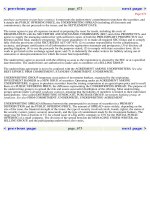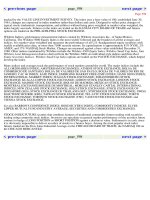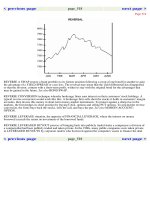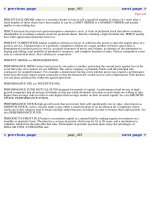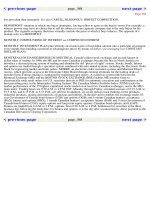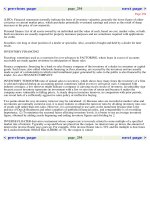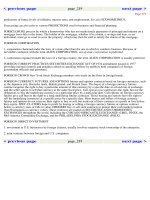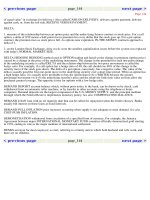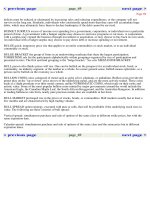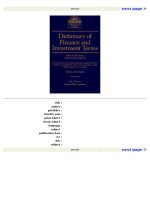Medical Terminology Simplified - Gylys, Barbara, Masters, Regina 5th edition
Bạn đang xem bản rút gọn của tài liệu. Xem và tải ngay bản đầy đủ của tài liệu tại đây (13.65 MB, 674 trang )
3971_FM_i-xxvi 13/02/14 11:57 AM Page xxvi
3971_FM_i-xxvi 13/02/14 11:57 AM Page xxvi
3971_FM_i-xxvi 13/02/14 11:57 AM Page xxvi
3971_FM_i-xxvi 13/02/14 11:56 AM Page iv
Must-have information… ANYTIME, ANYWHERE.
§ FREE, 1-year subscription to Taber’s Online
§ 33,000 audio pronunciations
§ Animations, videos & activities
The choice is yours.
www.FADavis.com
T
aber’s
®
T
aber’s
®
brings meanings to life!
Find yours today at
www.FADavis.com
Medical Terminology
Simplied
A Programmed Learning Approach by Body System
FIFTH EDITION
Barbara A. Gylys (GI
˘
L-ı˘s), BS, MEd, CMA-A
(AAMA)
Professor Emerita
College of Health and Human Services
University of Toledo
Toledo, OH
Regina M. Masters, BSN, MEd, RN, CMA
(AAMA)
Adjunct Nursing Faculty
Lourdes University
Sylvania, OH
3971_FM_i-xxvi 13/02/14 11:57 AM Page v
F. A. Davis Company
1915 Arch Street
Philadelphia, PA 19103
www.fadavis.com
Copyright © 2014 by F. A. Davis Company
Copyright © 2014 by F. A. Davis Company. All rights reserved. This product is protected by copyright. No
part of it may be reproduced, stored in a retrieval system, or transmitted in any form or by any means, elec-
tronic, mechanical, photocopying, recording, or otherwise, without written permission from the publisher.
Printed in the United States of America
Last digit indicates print number: 10 9 8 7 6 5 4 3 2 1
Publisher: Quincy McDonald
Manager of Content Development: George W. Lang
Developmental Editor: Brenna H. Mayer
Art and Design Manager: Carolyn O’Brien
As new scientific information becomes available through basic and clinical research, recommended treat-
ments and drug therapies undergo changes. The author(s) and publisher have done everything possible to
make this book accurate, up to date, and in accord with accepted standards at the time of publication. The
author(s), editors, and publisher are not responsible for errors or omissions or for consequences from ap-
plication of the book, and make no warranty, expressed or implied, in regard to the contents of the book.
Any practice described in this book should be applied by the reader in accordance with professional stan-
dards of care used in regard to the unique circumstances that may apply in each situation. The reader is ad-
vised always to check product information (package inserts) for changes and new information regarding
dose and contraindications before administering any drug. Caution is especially urged when using new or
infrequently ordered drugs.
Library of Congress Cataloging-in-Publication Data
Gylys, Barbara A., author.
Medical terminology simplified: a programmed learning approach by body system/Barbara A. Gylys,
Regina M. Masters. — Fifth edition.
p.; cm.
Includes index.
ISBN 978-0-8036-3971-3
I. Masters, Regina M., 1959- author. II. Title.
[DNLM: 1. Terminology as Topic—Programmed Instruction. W 15]
R123
610.1’4—dc23
2014000092
Authorization to photocopy items for internal or personal use, or the internal or personal use of specific
clients, is granted by F. A. Davis Company for users registered with the Copyright Clearance Center (CCC)
Transactional Reporting Service, provided that the fee of $.25 per copy is paid directly to CCC, 222 Rose-
wood Drive, Danvers, MA 01923. For those organizations that have been granted a photocopy license by
CCC, a separate system of payment has been arranged. The fee code for users of the Transactional Reporting
Service is: 978-0-8036-3971-3/14 0 + $.25.
3971_FM_i-xxvi 13/02/14 11:57 AM Page vi
This Book is Dedicated with Love
to my best iend, colleague, and husband, Julius A. Gylys
and
to my children, Regina Maria and Julius A., II
and
to Andrew Masters, Dr. Julia Halm, Caitlin Masters, Anthony Bishop-Gylys, Matthew Bishop-Gylys,
Liam Halm, and the little one, Harrison Robert.
—B
ARBARA
G
YLYS
to my mother, best friend, mentor, and co-author, Barbara A. Gylys
and
to my father, Dr. Julius A. Gylys
and
to my husband, Bruce Masters, and my children Andrew, Dr. Julia, and Caitlin, all of whom have
given me continuous encouragement and support, and to my grandsons Liam and Harrison who
bring me endless joy.
—R
EGINA
M
ASTERS
3971_FM_i-xxvi 13/02/14 11:57 AM Page vii
Preface
Building on the success of the past edition, Medical Terminology Simplied: A Programmed Learning Approach by
Body System, 5th edition, continues to live up to its established track record of reecting current trends and new ap-
proaches to teaching medical terminology. is edition includes a variety of special features to make studying medical
terminology a more encompassing and rewarding experience. We have continued to develop new features, based on
feedback from instructors and students. A review of the “What’s Inside” section provides explanations and illustrations
about all of the text’s distinctive features, as well as a short introduction to the many resources available to support
the text. e design and exibility of Simplied, 5th edition, enables its use as a self-instructional book, as an eBook,
or as a text in traditional lecture and classroom environments. e organization and pedagogical devices are designed
to help instructors teach and students learn medical terminology easily and quickly. When students use the available
learning tool, they will nd that the language of medicine stays with them and they can quickly apply the terminology
in the clinical eld.
is edition also continues to present eponyms without showing the possessive form, such as Alzheimer disease,
Down syndrome, and Parkinson disease. Medical dictionaries, as well as the American Association for Medical Tran-
scription and the American Medical Association, support these changes. A summary of common symbols and an up-
dated list of “do-not-use” abbreviations are provided in Appendix E: Abbreviations and Symbols. In addition, all
outdated medical terms in the textbook have been replaced with the most recent, state-of-the-art terms.
CHAPTERS
We have enhanced the popular, eective features found in the previous edition, so the learner can easily apply and process
the language of medicine correctly in the workplace. e main focus of this edition is to improve retention of medical
terms and relate their applications in the clinical setting. e following is a brief summary of chapter content.
• Chapter 1 introduces the programmed learning, medical word-building approach. It also includes summaries
and activities to reinforce retention of common suxes and prexes used in medical word building.
• Chapter 2 discusses the structural organization of the human body.
• Chapters 3 through 11 are organized according to specic body systems and may be taught in any sequence.
These chapters include key anatomical and physiological terms; anatomy and physiology; combining forms,
suxes, and prexes; terms related to signs, symptoms, and diseases, as well as diagnostic, surgical, and medical
procedures; and abbreviations. Included are section reviews and medical record activities. All activities allow
self-assessment and evaluation of competency.
APPENDICES
e appendices oer learning tools to help reinforce the information presented in the chapters. Your students will
also nd the appendices useful for study, review, and reference as they begin their careers in the allied health eld.
• Appendix A: Glossary of Medical Word Elements contains alphabetical lists of medical word elements with
corresponding meanings.
• Appendix B: Answer Key provides answers to anatomical labeling and section and chapter reviews, as well as
the medical record activities.
• Appendix C: Index of Diagnostic, Medical, and Surgical Procedures summarizes procedures covered in the text-
book that establish a diagnosis, as well as various methods of treatment.
• Appendix D: Drug Classications provides information on prescription and nonprescription drugs used for the
treatment of various medical conditions.
viii
3971_FM_i-xxvi 13/02/14 11:57 AM Page viii
• Appendix E: Abbreviations and Symbols summarizes commonly used medical abbreviations and symbols,
including their meanings.
• Appendix F: Medical Specialties provides a summary and description of medical specialties.
• Appendix G: Glossary of English-to-Spanish Translations is an enhanced appendix of English-to-Spanish vocab-
ulary and phrases relevant to various medical specialties. It is intended to help health-care workers who do not
speak Spanish but who encounter Spanish-speaking patients in the medical environment.
LEARNING STYLES
All enhancements in the h edition are constructed to improve retention and make the study of medical terminology
more enjoyable and engaging. As more and more students identify themselves as visual learners, the authors met this
challenge by ensuring that the illustrations in the text and ancillary products are as helpful to students as possible.
Many of the gures depicting the toughest topics for students to grasp have been newly developed; others from the
previous edition have been enhanced for clarity and ease of understanding. us, one of the most extraordinary features
of this edition is the collection of visually outstanding, full-color illustrations. ese illustrations are extremely useful
as students learn the association of medical terms to anatomy, physiology, pathology, and medical treatments of the
human body. All of the artwork presents precise depictions of medical terms in action. Full-color gures enable
students to see a true representation of the body system, pathological condition, or operative procedure.
Programmed Learning Approach
e programmed learning approach presents a word-building method for developing a medical vocabulary in an eec-
tive, interesting manner. e book is designed to help students learn skills that will enable them to analyze medical
terms by breaking them down into their basic components. By learning and reinforcing this technique, students will
master the terms in this book and learn to decipher new medical terms that they encounter in the workplace. It is not
a book in which the student simply memorizes a list of vocabulary terms. In addition, the text can be used in a tradi-
tional classroom setting or with guidance from an instructor for independent study. e workbook text format is
designed to guide the student through exercises that teach and reinforce medical terminology.
e programmed learning technique makes use of frames, or isolated pieces of information that, together, give the
student the building blocks of medical terminology. e frames, each numbered with the chapter number and then
the frame number within that chapter, allow students to learn at their own pace and in their own way. Each frame
contains not only information about terminology, but also ll-in lines students can use to reinforce understanding of
the information. e student can nd the answer to each ll-in line in the frame’s answer box, located at the le of
the page.
e key to using frames wisely is the bookmark included with every book. Students should use it to cover the answer
column to verify their understanding of the content provided in the frame. Pronunciation keys for all medical words
are also included in the frame answer boxes. Newly designed pronunciation guides in each chapter help students pro-
nounce medical terms correctly.
TEACHING AND LEARNING PACKAGE
Numerous teaching aids are available free of charge to instructors who adopt Medical Terminology Simplied: A
Programmed Learning Approach by Body System, 5th edition. ese teaching aids contain an abundance of information
and activities to help students retain what they have learned in a given chapter. Various types of electronic resources
are designed to enhance course content and ensure a program of excellence in a medical terminology curriculum.
ese resources will also help you plan course work and provide you with various types of presentations to reinforce
the learning process. ese teaching aids include the Web-based Medical Language Lab and the DavisPlus Online
Resource Center for students and instructors.
Medical Language Lab
Included in every new copy of Medical Terminology Simplied: A Programmed Learning Approach by Body System,
5th edition, is access to the ultimate online medical terminology resource for students. e Medical Language Lab is
a rich learning environment using proven language development methods to help students become eective users of
medical language. To access the Medical Language Lab, students simply go to
Preface
ix
3971_FM_i-xxvi 13/02/14 11:57 AM Page ix
and register using the access code provided in their new copies of Medical Terminology Simplied: A Programmed
Learning Approach by Body System, 5th edition.
Each lesson in the Medical Language Lab enables students to develop skills to critically listen for important terms,
respond to others using medical terminology, and generate their own terminology-rich writing and speech. By
following the activities in each lesson, students graduate from simple memorization to becoming stronger users of the
medical language.
Designed to work seamlessly with Medical Terminology Simplied: A Programmed Learning Approach by Body Sys-
tem, 5th edition, each activity in the Medical Language Lab has been craed with content specic to the textbook.
Every chapter in the textbook has a corresponding lesson in the Medical Language Lab. A designated icon found
within the chapters tells students when it is most advantageous to integrate the activities on the Medical Language
Lab into their studies. Students can be condent that every activity in the Medical Language Lab is relevant to the
language of medicine and helps facilitate the learning process.
Some of the activities in the Medical Language Lab include the following:
• Interactive audio activities that demonstrate the most effective use of medical terminology in clinical settings
• Flash-card activities for preview and practice to reinforce word elements presented in the chapter
• Word search games that present a variety of medical terms to reinforce word recognition and spelling in a fun
activity
• Labeling activities that build understanding of anatomical terms
• Short denitions of selected terms from Taber’s Cyclopedic Medical Dictionary, 22nd edition, the most trusted
medical dictionary in the world
DavisPlus Online Resource Center
e DavisPlus website, accessed at , is a study companion website for Simplied, 5th edition.
It provides activities to accelerate learning and reinforce information presented in each chapter. A designated icon
found within the chapters tells students when it is most advantageous to integrate the activities on the DavisPlus
website into their studies. All online exercises provide instructions for completing the various activities.
e multimedia activities available at the DavisPlus Online Resource Center include the following:
• Audio exercises of pronunciations and meanings of newly introduced medical terms from the word elements
tables (Chapters 1 through 11), designed to strengthen spelling, pronunciation, and meanings of selected
medical terms and develop medical transcription skills
• Medical record exercises (Chapters 3 through 11) that allow students to click highlighted terms in the medical
record and hear their correct pronunciations and meanings to strengthen understanding of medical terms
• Animations, such as exploration of the pathology of gastroesophageal reux disease (GERD) or the various
stages of pregnancy and delivery, to help students better understand complex processes and procedures
• Study questions for Chapters 1 through 11, which students can answer after completing a chapter to
determine their competency level for the chapter and understand how the multiple-choice questions are
constructed in the electronic test bank and on accreditation examinations
• The Medical Language Lab (MLL), the new, interactive, online program that helps the student master the
language of medicine, which can also be accessed from the DavisPlus site
Instructor Online Resource Center
e Instructor Online Resource Center provides an abundance of updated, innovative supplemental teaching
aids. ese teaching aids are designed to help instructors plan course work, enhance presentations, and make teaching
medical terminology easier and more eective. Instructors can use these teaching tools in various educational settings,
including the traditional classroom, distance learning, or independent studies. When the instructor integrates them
into course content, they will provide a sound foundation for developing an extensive medical vocabulary and guar-
antee a full program of medical terminology excellence for all students. e Instructor Online Resource Center includes
the following resources:
• Activity Pack
• PowerPoint lecture notes
• Image resource
• Electronic test bank
• Resource kit
x Preface
3971_FM_i-xxvi 13/02/14 11:57 AM Page x
Preface
xi
• Teaching and Student Guides
• Davis Digital Version
ACTIVITY PACK
e printable Activity Pack is a resource full of instructional support for using the textbook and ancillary products.
It has been broadened and enhanced to meet the challenges of today’s instructional needs.
It is available in PDF format on the Instructor’s Online Resource Center. e h edition of the Activity Pack
includes the following materials:
• Course Outlines. Suggested course outlines help the instructor determine a comfortable pace and plan the best
method of covering the material presented in the textbook.
• Clinical Connection Activities. These activities integrate clinical scenarios in each chapter as a solid reinforce-
ment of content. Instructors should feel free to select activities they deem suitable for their course and decide
whether the students should complete the activity independently, with peers, or as a group project.
• Student- and Instructor-Directed Activities. These are updated teaching aids with new ones added for this
edition. They offer a variety of activities for each body system chapter. Activities can serve as course require-
ments or supplemental material. In addition, instructors can assign them as individual or collaborative
projects. For group projects, Peer Evaluation Forms are provided.
• Oral and Written Research Projects. The research projects provide an opportunity for students to hone their
research skills. The Community and Internet Resources section offers an updated list of technical journals,
community organizations, and Internet sources that students can use to complete the oral and written
projects. This section also includes an evaluation template for the oral and written research projects.
These projects will add variety and interest to the course while reinforcing the learning process.
• Anatomy Test Questions. Instructors can use the anatomy test questions for anatomy review or as a testing
device. These questions also include an illustration for each body system chapter. An answer key is also
provided.
• Supplemental Medical Record Activities. We have updated the supplemental medical record activities and
added new activities to this edition. As in the textbook, these medical record activities use common clinical
scenarios to show how the student would use medical terminology in the clinical area to document patient
care. Each medical record includes activities for terminology, pronunciation, and medical record analysis. In
addition, each medical record focuses on a specic medical specialty. Instructors can use these records for
group activities, oral reports, medical coding activities, or individual assignments. The medical records are
designed to reinforce and enhance terminology presented in the textbook. An answer key is also provided.
• Crossword Puzzles. These fun, educational activities reinforce material covered in each body system chapter.
Instructors can use them for an individual or group activity, an extra credit opportunity, or just for fun. An
answer key is included for each puzzle.
• Anatomy Coloring Activities. Anatomy coloring activities, included for each body system chapter, help
reinforce the positions of the main organs that compose a particular body system.
• Terminology Answer Keys. In response to requests from instructors, this section summarizes the answers to the
Terminology tables in the medical records sections of the textbook. This added feature provides instructional
support in using the textbook and assists instructors in correcting terminology assignments.
POWERPOINT LECTURE NOTES
Simplied, 5th edition, contains a completely updated and expanded PowerPoint Lecture Notes package that instructors
can easily integrate, modify, or enhance to meet their classroom needs. We have developed over 1,270 slides for this
edition, including numerous, full-color illustrations with captions from the textbook and other sources. e Power-
Point Lecture Notes slides also contain pedagogical notes for each chapter (at the bottom of the slide) to reinforce
comprehension and oer suggestions for a higher retention level for material discussed. In addition, instructors can
also arrange to use the PowerPoint presentations for independent study purposes.
e PowerPoint Lecture Notes provide an outline-based presentation for each body system chapter. Each presen-
tation contains a chapter overview, the structure and functions of each body system, and selected pathology, vocabulary,
and diagnostic medical and surgical procedures for each body system chapter. In addition, various exercises, including
clinically related exercises, are included to verify retention of material presented.
3971_FM_i-xxvi 13/02/14 11:57 AM Page xi
IMAGE RESOURCE
We have enhanced and expanded the Image Resource, a popular feature of the past edition, to meet the current
demands of numerous instructors. e Image Resource is an electronic image bank that contains all illustrations from
the textbook. It is fully searchable and allows users to zoom in and out and display a JPG image of an illustration that
can be copied into a Microso Word document or PowerPoint presentation.
ELECTRONIC TEST BANK
e electronic test bank uses ExamView Pro, a powerful, user-friendly test-generation program. It enables instructors
to create custom-made or randomly generated tests in a printable format from a test bank of more than 1,230 test
items, with 370 new test items for this edition. e test bank includes multiple-choice, matching, true-false, and med-
ical word–building questions. Because of the exibility of the ExamView Pro test-generating program, instructors can
edit questions in the test bank to meet their specic educational needs. erefore, if instructors wish to restate,
embellish, or streamline questions or change distractors, they can do so with little eort. ey can also add questions
to the test bank. e ExamView Pro program is available for PC and Macintosh users.
RESOURCE KIT
Learning Management Systems Resource Kit is available for Blackboard, Angel, Moodle, Canvass, and SCORM-
compliant systems.
TEACHING AND STUDENT GUIDES
e Teaching and Student Guides are extensive instructional aids matched to every lecture in a common single-term
Medical Terminology course. e Teaching Guide is lled with sample homework assignments, in-class activities,
and extensive lecture notes with suggested topic durations. When viewed electronically, the Teaching Guide also pro-
vides live hyperlinks to the instructor resources on DavisPlus. e accompanying Student Guide may be distributed
to students at the instructor’s discretion. e Student Guide contains study tips, lists of accompanying resources, and
a list of the homework assignments from the Teaching Guide.
DAVIS DIGITAL VERSION
Adopters have access to the complete content of the text online in a searchable format that can be bookmarked and
accessed wherever you have a browser with a live Internet connection.
TermPlus
TermPlus 3.0 is a powerful, interactive CD-ROM program that is available for this edition as a separate product.
TermPlus is a popular competency-based, self-paced, multimedia program that includes graphics, audio, and a dic-
tionary culled from Taber’s Cyclopedic Medical Dictionary, 22nd edition. Help menus provide navigational support.
e soware comes with numerous interactive learning activities, including the following:
xii Preface
• Anatomy Focus
• Tag the Elements
• Spotlight the Elements
• Concentration
• Build Medical Words
• Programmed Learning
• Medical Vocabulary
• Chart Notes
• Spelling
• Crossword Puzzles
• Word Scramble
• Terminology Teaser
All activities can be graded and the results printed or e-mailed to an instructor. is feature makes TermPlus
especially valuable as a distance-learning tool because it provides evidence of student drill and practice in various
learning activities.
3971_FM_i-xxvi 13/02/14 11:57 AM Page xii
Preface
xiii
HOW TO USE THIS BOOK
is self-instructional book is designed to provide the student with skills to learn medical terminology easily and
quickly. e book’s design and exibility enable its use as a self-instructional book or one that can be used in traditional
lecture and classroom environments. e following distinctive features are included in this learning package:
• The programmed learning approach presents a word-building method for developing a medical vocabulary in
an effective, interesting manner. It is designed for use in a traditional classroom setting or for independent
study with an instructor.
• The workbook-text format is designed to guide you through exercises that teach and reinforce medical
terminology.
• Numerous activities in each unit are designed to enable the student to be interactively involved in the learning
process. Writing, reading, listening, visualizing, and keyboarding encompass the various learning styles employed
in the book to help the student master medical terminology. With this method, the student will not only under-
stand but also remember the signicant concepts of medical word building.
• Students learn by active participation. In this book, students write answers in response to blocks of informa-
tion, complete section review exercises, and analyze medical reports. If a student is not satised with his or her
level of comprehension after the review exercises, reinforcement frames direct the student to go back and
rework the corresponding informational frames.
• New to this edition is a designated icon in each chapter that directs the student to visit the Medical
Language Lab for a ash-card review of word elements covered in the chapter.
• The audio exercises provide reinforcement of pronunciation, denitions, and spelling practice of medical
terms. The terms and pronunciations are now available by visiting the DavisPlus website.
• Pronunciation keys for all medical words are included in the frame answer boxes and help the student
pronounce each term correctly. Newly designed pronunciation guides in each chapter give the student a
more accurate understanding of the proper pronunciation of medical words.
• The appendices include many tools students can use as references when they begin working in the clinical
eld.
We hope the pedagogical and visual features of Medical Terminology Simplied: A Programmed Learning Approach
by Body System, 5th edition, make learning the language of medicine an exciting, rewarding process. We invite
instructors and students to continue the tradition of sending their suggestions to the F. A. Davis Company so that
we can consider them for the next edition.
—B
ARBARA
A. G
YLYS
—R
EGINA
M. M
ASTERS
3971_FM_i-xxvi 13/02/14 11:57 AM Page xiii
Reviewers
J
ANNA
F. E
DRINGTON
, MSN, RNC, ARNP
Assistant Professor
Nursing
Luther College
Decorah, IA
D
AWN
H
AMMERSCHMIDT
, PhD, ATC
Assistant Professor
Health and Physical Education
Minnesota State University
Moorhead, MN
P
ATRICIA
H
ODSON
, PT, DPT
Clinical Professor and Director of Clinical
Education
Health Sciences
East Carolina University
Greenville, NC
M
ARIE
L. K
OTTER
, PhD
Department Chair
Physical erapy
Weber State University
Ogden, UT
C
ATHERINE
N
OWAK
, MS, PA-C
Associate Program Director
Physician Assistant Program
Mercy College
Bronx, NY
C
HRISTINE
M. P
ETRAGLIA
, RPh, MSEd
Adjunct Faculty
Health and Natural Sciences
Holyoke Community College
Holyoke, MA
C
AROLYN
S
CHEESE
, RN, MS
Director, Simulation Learning Center—Faculty
Instructor—Clinical
College of Nursing
University of Utah
Salt Lake City, UT
G
LYNDA
R. S
HERRILL
, RN, MS
Practical Nursing Instructor, Might Medical
Terminology Instructor
Practical Nursing
Indian Capital Technology Center
Tahlequah, OK
G
INA
T
ICE
, MSRS, RT(R)
Clinical Coordinator
Radiologic Technology Program
Gadsden State Community College
Gadsden, AL
xiv
3971_FM_i-xxvi 13/02/14 11:57 AM Page xiv
xv
Acknowledgments
e h edition of Medical Terminology Simplied: A Programmed Learning Approach by Body System was greatly
improved by comments that the authors received from the many users of previous editions—both educators and
students. Although there are too many people to acknowledge individually, we are deeply grateful to each one. As in
the past, the editorial and production stas at F. A. Davis have inspired, guided, and shaped this project. e authors
would like to acknowledge the valuable contributions of F. A. Davis’s editorial and production team who were
responsible for this project:
• Quincy McDonald, Publisher, provided the overall design and layout for the fth edition. He was instrumen-
tal in assisting the authors in designing a wide variety of state-of-the-art pedagogical products within the text
to aid students in their learning activities and to help instructors plan course work and presentations. These
teaching aids are described in the Teaching and Learning Package section of the Preface.
• Elizabeth Schaeffer, Developmental Editor of Electronics, patiently and enthusiastically addressed our numer-
ous questions and background queries to ensure the textbook was appropriately updated and accurately revised.
• George W. Lang, Manager of Content Development, expertly guided the manuscript through the developmental
and production phases of the process.
• Brenna H. Mayer, Developmental Editor, systematically and meticulously read the manuscript, helping it
along at every stage of production.
• Margaret Biblis, Publisher, once again provided her support and efforts for the quality of the nished product.
We also acknowledge and thank our exceptionally dedicated publishing partners who helped guide and shape this
large project:
• Alisa Hathaway, Editorial Assistant
• Robert Butler, Production Manager
• Kate Margeson, Illustrations Coordinator
• Carolyn O’Brien, Art and Design Manager
• Linda Van Pelt, Managing Editor
• Kirk Pedrick, Electronic Product Development Manager, Electronic Publishing
• Elizabeth Y. Stepchin, Developmental Associate
We also we extend our sincerest gratitude to Neil Kelly, Director of Sales, and his sta of sales representatives,
whose continued eorts have undoubtedly contributed to the success of this textbook.
3971_FM_i-xxvi 13/02/14 11:57 AM Page xv
Contents at a Glance
CHAPTER 1 Introduction to Programmed Learning
and Medical Word Building
1
CHAPTER 2 Body Structure 27
CHAPTER 3 Integumentary System 63
CHAPTER 4 Respiratory System 107
CHAPTER 5 Cardiovascular and Lymphatic Systems 155
CHAPTER 6 Digestive System 217
CHAPTER 7 Urinary System 277
CHAPTER 8 Reproductive Systems 329
CHAPTER 9 Endocrine and Nervous Systems 393
CHAPTER 10 Musculoskeletal System 453
CHAPTER 11 Special Senses: Eyes and Ears 507
APPENDICES
APPENDIX A Glossary of Medical Word Elements 548
APPENDIX B Answer Key 558
APPENDIX C Index of Diagnostic, Medical, and Surgical Procedures 604
APPENDIX D Drug Classications 607
APPENDIX E Abbreviations and Symbols 613
APPENDIX F Medical Specialties 622
APPENDIX G Glossary of English-to-Spanish Translations 624
Index 633
Rules for Singular and Plural Sufxes Facing the inside back coer
Pronunciation Guidelines Inside back coer
xvi
3971_FM_i-xxvi 13/02/14 11:57 AM Page xvi
xvii
Contents
CHAPTER 1 Introduction to Programmed Learning and Medical Word
Building
1
Objectives 1
Instructions 2
Word Elements 3
Word Root 4
Combining Forms 5
Suxes 8
Prexes 13
Pronunciation Guidelines 15
Pronunciation Tools 15
Section Review 1–1 16
Common Suxes 16
Surgical Suxes 16
Diagnostic Suxes 18
Pathological Suxes 19
Plural Suxes 21
Section Review 1–2 22
Common Prexes 23
CHAPTER 2 Body Structure 27
Objectives 27
Word Elements 29
Section Review 2–1 31
Basic Units of Structure 31
Directional Terms 32
Section Review 2–2 39
Word Elements 40
Section Review 2–3 41
Body Planes and Cavities 41
Body Planes 41
Body Cavities 44
3971_FM_i-xxvi 13/02/14 11:57 AM Page xvii
Abdominopelvic uadrants and Regions 45
Abdominopelic uadrants 46
Abdominopelic Regions 46
Section Review 2–4 49
Abbreviations 50
Additional Medical Terms 50
Diseases and Conditions 50
Diagnostic Procedures 51
Medical and Surgical Procedures 54
Additional Medical Terms Review 55
Body Structure Chapter Review 56
Word Elements Summary 56
Word Elements Chapter Review 57
uadrants and Regions Review 61
CHAPTER 3 Integumentary System 63
Objectives 63
Medical Specialty 63
Dermatology 63
Anatomy and Physiology Overview 63
Word Elements 64
Section Review 3–1 67
Skin and Accessory Organs 67
Skin 67
Accessory Organs of the Skin 73
Section Review 3–2 77
Combining Forms Denoting Color 78
Section Review 3–3 83
Abbreviations 84
Additional Medical Terms 84
Diseases and Conditions 84
Diagnostic Procedures 90
Medical and Surgical Procedures 91
Pharmacology 92
Additional Medical Terms Review 93
Primary and Secondary Lesions Review 94
Medical Record Activities 95
Medical Record Activity 3–1: Compound Nevus 95
Medical Record Activity 3–2: Psoriasis 97
Integumentary System Chapter Review 100
Word Elements Summary 100
Word Elements Chapter Review 101
Vocabulary Review 105
xviii Contents
3971_FM_i-xxvi 13/02/14 11:57 AM Page xviii
CHAPTER 4 Respiratory System 107
Objectives 107
Medical Specialty 107
Pulmonology 107
Anatomy and Physiology Overview 107
Word Elements 109
Section Review 4–1 111
Respiratory System 111
Upper Respiratory Tract 111
Section Review 4–2 117
Lower Respiratory Tract 118
Section Review 4–3 131
Abbreviations 132
Additional Medical Terms 133
Diseases and Conditions 133
Diagnostic Procedures 136
Medical and Surgical Procedures 138
Pharmacology 139
Additional Medical Terms Review 141
Medical Record Activities 142
Medical Record Activity 4–1: Upper Airway Obstruction 142
Medical Record Activity 4–2: Bronchoscopy 144
Respiratory System Chapter Review 147
Word Elements Summary 147
Word Elements Chapter Review 149
Vocabulary Review 153
CHAPTER 5 Cardiovascular and Lymphatic Systems 155
Objectives 155
Medical Specialties 155
Cardiology 155
Immunology 155
Anatomy and Physiology Overview 156
Word Elements 157
Section Review 5–1 159
Cardiovascular System 159
Layers of the Heart Wall 159
Circulation and Heart Structures 161
Blood Flow rough the Heart 166
Heart Vales 171
Section Review 5–2 173
Contents
xix
3971_FM_i-xxvi 13/02/14 11:57 AM Page xix
Conduction Pathway of the Heart 174
Cardiac Cycle and Heart Sounds 176
Lymphatic System 181
Word Elements 182
Section Review 5–3 183
Lymphatic Structures 183
Tonsil, Spleen, and ymus 186
Section Review 5–4 188
Abbreviations 189
Additional Medical Terms 190
Diseases and Conditions 190
Diagnostic Procedures 194
Medical and Surgical Procedures 198
Pharmacology 202
Additional Medical Terms Review 203
Medical Record Activities 204
Medical Record Activity 5–1: Myocardial Infarction 204
Medical Record Activity 5–2: Cardiac Catheterization 206
Cardiovascular and Lymphatic Systems Chapter Review 208
Word Elements Summary 208
Word Elements Chapter Review 210
Vocabulary Review 216
CHAPTER 6 Digestive System 217
Objectives 217
Medical Specialty 217
Gastroenterology 217
Anatomy and Physiology Overview 217
Word Elements 219
Section Review 6–1 221
Upper GI Tract 221
Oral Cavity 221
Esophagus, Pharynx, and Stomach 226
Section Review 6–2 232
Word Elements 233
Section Review 6–3 234
Lower GI Tract 234
Small and Large Intestine 234
Rectum and Anus 240
Section Review 6–4 243
Word Elements 244
Section Review 6–5 245
Accessory Organs of Digestion 245
Liver 246
xx Contents
3971_FM_i-xxvi 13/02/14 11:57 AM Page xx
Gallbladder 247
Pancreas 251
Section Review 6–6 254
Abbreviations 255
Additional Medical Terms 255
Diseases and Conditions 255
Diagnostic Procedures 260
Medical and Surgical Procedures 262
Pharmacology 263
Additional Medical Terms Review 264
Medical Record Activities 265
Medical Record Activity 6–1: Rectal Bleeding 265
Medical Record Activity 6–2: Carcinosarcoma of the Esophagus 267
Digestive System Chapter Review 269
Word Elements Summary 269
Word Elements Chapter Review 271
Vocabulary Review 276
CHAPTER 7 Urinary System 277
Objectives 277
Medical Specialties 277
Urology 277
Nephrology 277
Anatomy and Physiology Overview 278
Word Elements 280
Section Review 7–1 282
Macroscopic Structures 282
Kidneys 282
Section Review 7–2 289
Ureters, Bladder, and Urethra 289
Section Review 7–3 296
Microscopic Structures 296
Section Review 7–4 304
Abbreviations 305
Additional Medical Terms 305
Diseases and Conditions 305
Diagnostic Procedures 307
Medical and Surgical Procedures 309
Pharmacology 313
Additional Medical Terms Review 314
Medical Record Activities 315
Medical Record Activity 7–1: Cystitis 315
Medical Record Activity 7–2: Dysuria with Benign Prostatic Hypertrophy 317
Contents
xxi
3971_FM_i-xxvi 13/02/14 11:57 AM Page xxi
Urinary System Chapter Review 320
Word Elements Summary 320
Word Elements Chapter Review 322
Vocabulary Review 327
CHAPTER 8 Reproductive Systems 329
Objectives 329
Medical Specialties 329
Gynecology 329
Obstetrics 329
Obstetrics and Gynecology 329
Urology 330
Anatomy and Physiology Overview 330
Female Reproductive System 330
Word Elements 332
Section Review 8–1 334
Section Review 8–2 344
Section Review 8–3 353
Male Reproductive System 354
Word Elements 354
Section Review 8–4 356
Section Review 8–5 365
Abbreviations 366
Additional Medical Terms 366
Diseases and Conditions 366
Diagnostic Procedures 372
Medical and Surgical Procedures 375
Pharmacology 379
Additional Medical Terms Review 380
Medical Record Activities 381
Medical Record Activity 8–1: Postmenopausal Bleeding 381
Medical Record Activity 8–2: Bilateral Vasectomy 383
Reproductive Systems Chapter Review 385
Word Elements Summary 385
Word Elements Chapter Review 387
Vocabulary Review 391
CHAPTER 9 Endocrine and Nervous Systems 393
Objectives 393
Medical Specialties 393
Endocrinology 393
Neurology 393
xxii Contents
3971_FM_i-xxvi 13/02/14 11:57 AM Page xxii
Anatomy and Physiology Overview 394
Endocrine System 394
Word Elements 396
Section Review 9–1 398
Hormones 398
Pituitary Gland 400
Table 9–1: Pituitary Hormones 404
yroid Gland 405
Table 9–2: yroid Hormones 407
Section Review 9–2 408
Parathyroid Glands 408
Table 9–3: Parathyroid Hormone 409
Adrenal Glands 410
Table 9–4: Adrenal Hormones 411
Pancreas (Islets of Langerhans) 411
Table 9–5: Pancreatic Hormones 413
Pineal and ymus Glands 415
Ovaries and Testes 415
Section Review 9–3 417
Nervous System 417
Word Elements 419
Section Review 9–4 420
Brain 420
Spinal Cord 422
Mental Disorders 426
Section Review 9–5 428
Abbreviations 429
Additional Medical Terms 429
Diseases and Conditions 429
Diagnostic Procedures 435
Medical and Surgical Procedures 437
Pharmacology 438
Additional Medical Terms Review 439
Medical Record Activities 440
Medical Record Activity 9–1: Diabetes Mellitus 440
Medical Record Activity 9–2: Stroke 443
Endocrine and Nervous Systems Chapter Review 446
Word Elements Summary 446
Word Elements Chapter Review 448
Vocabulary Review 452
Contents
xxiii
3971_FM_i-xxvi 13/02/14 11:57 AM Page xxiii
CHAPTER 10 Musculoskeletal System 453
Objectives 453
Medical Specialties 453
Orthopedics 453
Osteopathy 453
Chiropractic 454
Anatomy and Physiology Overview 454
Word Elements 455
Section Review 10–1 457
Muscles 457
Types of Muscle Fibers 457
Section Review 10–2 461
Skeletal System 462
Word Elements 463
Section Review 10–3 466
Structure and Function of Bones 466
Section Review 10–4 473
Joints 474
Combining Forms Related to Specic Bones 476
Fractures and Repairs 479
Vertebral Column 480
Section Review 10–5 485
Abbreviations 486
Additional Medical Terms 486
Diseases and Conditions 486
Diagnostic Procedures 492
Medical and Surgical Procedures 492
Pharmacology 493
Additional Medical Terms Review 494
Medical Record Activities 495
Medical Record Activity 10–1: Degenerative, Intervertebral Disk Disease 495
Medical Record Activity 10–2: Rotator Cu Tear, Right Shoulder 497
Musculoskeletal System Chapter Review 500
Word Elements Summary 500
Word Elements Chapter Review 502
Vocabulary Review 506
CHAPTER 11 Special Senses: Eyes and Ears 507
Objectives 507
Medical Specialties 507
Ophthalmology 507
Otolaryngology 507
Anatomy and Physiology Overview 508
xxiv Contents
3971_FM_i-xxvi 13/02/14 11:57 AM Page xxiv
